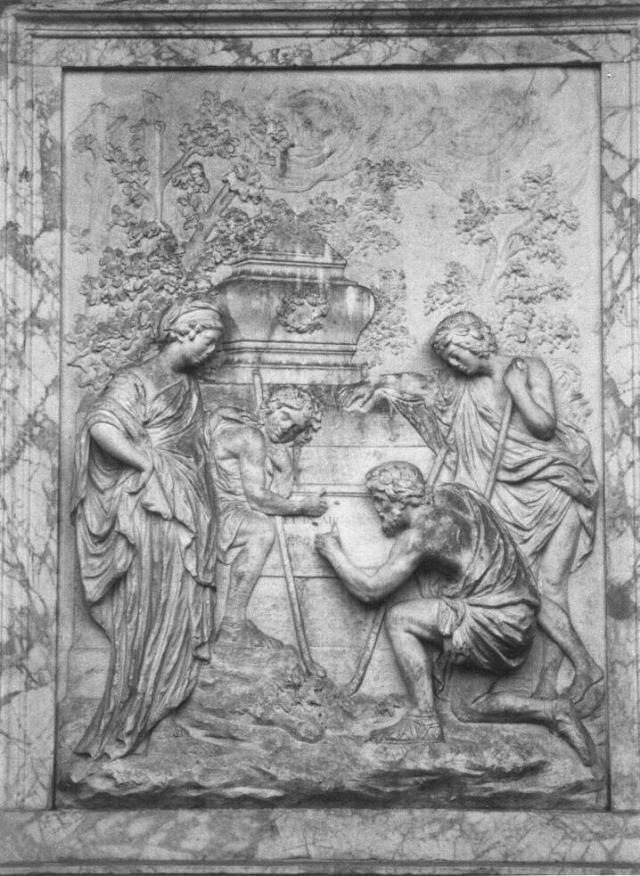
The Shugborough Inscription is a sequence of letters - O U O S V A V V, between the letters D M - carved on the 18th-century Shepherd's Monument in the grounds of Shugborough Hall in Staffordshire, England, below a mirror image of Nicolas Poussin's painting, the Shepherds of Arcadia. It has never been satisfactorily explained, and has been called one of the world's top uncracked ciphertexts. The inscription became widely known after being mentioned in the 1982 book The Holy Blood and the Holy Grail by Michael Baigent, Richard Leigh, and Henry Lincoln.
The monument was built sometime between 1748 and 1763, commissioned by Thomas Anson, paid for by his brother, Admiral George Anson, and fashioned by the Flemish sculptor Peter Scheemakers. The relief copy of the Poussin painting is contained within a rustic arch, and shows a woman and three shepherds, two of whom are pointing to a tomb. On the tomb is carved the Latin text Et in arcadia ego ("I am also in Arcadia" or "I am, even in Arcadia"). The carving displays a number of small alterations from the original painting, and an extra sarcophagushas been placed on top of the main tomb. Above the Poussin scene are two stone heads, one showing a smiling bald-headed man, the other bearing a likeness to the goat-horned Greek god Pan.
Below the relief carving on the monument, an unknown craftsman carved the mysterious eight letters, contained within the letters 'D M'. On Roman tombs, the letters 'D M' commonly stood for Dis Manibus, meaning "dedicated to the shades".
Josiah Wedgwood, Charles Darwin and Charles Dickens are all said to have attempted to solve the enigma and failed.
In recent decades, investigators have proposed several possible solutions. Some of these are acrostic, interpreting each letter as the initial letter of a word.
- One suggestion is that the eight letters are a coded dedication by George Anson to his deceased wife. In 1951 Morchard Bishop speculated that the letters might be an acronym for the Latin phrase Optimae Uxoris Optimae Sororis Viduus Amantissimus Vovit Virtutibus("Best of wives, Best of sisters, a most devoted Widower dedicates (this) to your virtues").
- Steve Regimbal interprets the letters as standing for a new Latin translation of the phrase "Vanity of vanities, saith the preacher; all is vanity." (Ecclesiastes 12:8), namely Orator Ut Omnia Sunt Vanitas Ait Vanitas Vanitatum. He has speculated that the phrase may be the source of the earlier inscription "OMNIA VANITAS" which may have been carved on an alcove at the estate of one of Thomas Anson's associates, George Lyttleton.
- Former NSA linguist Keith Massey interprets the letters as an acronym for the Latin phrase Oro Ut Omnes Sequantur Viam Ad Veram Vitam ("I pray that all may follow the Way to True Life") in reference to the Biblical verse John 14:6, Ego sum Via et Veritas et Vita ("I am the Way, the Truth and the Life").
- Margaret, Countess of Lichfield has claimed that the inscription was a love message, referring to the lines Out Your Own Sweet Vale, Alicia, Vanishes Vanity. Twixt Deity and Man Thou, Shepherdess, The Way, but no source for these words has ever been traced.
- A. J. Morton observes that some of the letters match the names of the residents of Shugborough in the early 19th century, and believes that the inscription denotes the words Orgreave United with Overley and Shugborough, Viscount Anson Venables Vernon.
Non-acrostic efforts include:
- a 2014 book by Dave Ramsden which references manuscript evidence from the Staffordshire Record Office to demonstrate that Thomas Anson's peers understood the monument to be a funerary monument, dedicated to a syncretic female figure known as the "Shepherdess". As such, the D. M. stands for Dis Manibus, and the 8-letter inscription is a cipher concealing the name of the figure being memorialized. The solution provides a detailed decryption effort which asserts that a polyalphabetic cipher was used to encrypt the name "Magdalen".
- a work by Peter Oberg where the letters stand for numbers which sum to 2,810, the distance in miles from Shugborough to the so-called "Money Pit" on Oak Island, in Nova Scotia, Canada.
- a suggestion that relies on pronouncing 'UOSV' as 'Iosef', interpreted as a reference to the biblical prophet Joseph.
- a proposal that 'VV' should be read as 'TEN', with reference to Roman numerals, and the 10 letters then read as an anagram of 'DEVOUT MASON'.
Despite the many theories, staff at Shugborough Hall remain skeptical of all proposed solutions. A spokesman for the property (now owned by the National Trust) was quoted in 2014 asserting, "We get five or six people a week who believe they have solved the code so we are a bit wary of them now."
Documentary video and possible solution for the cipher text

No comments:
Post a Comment